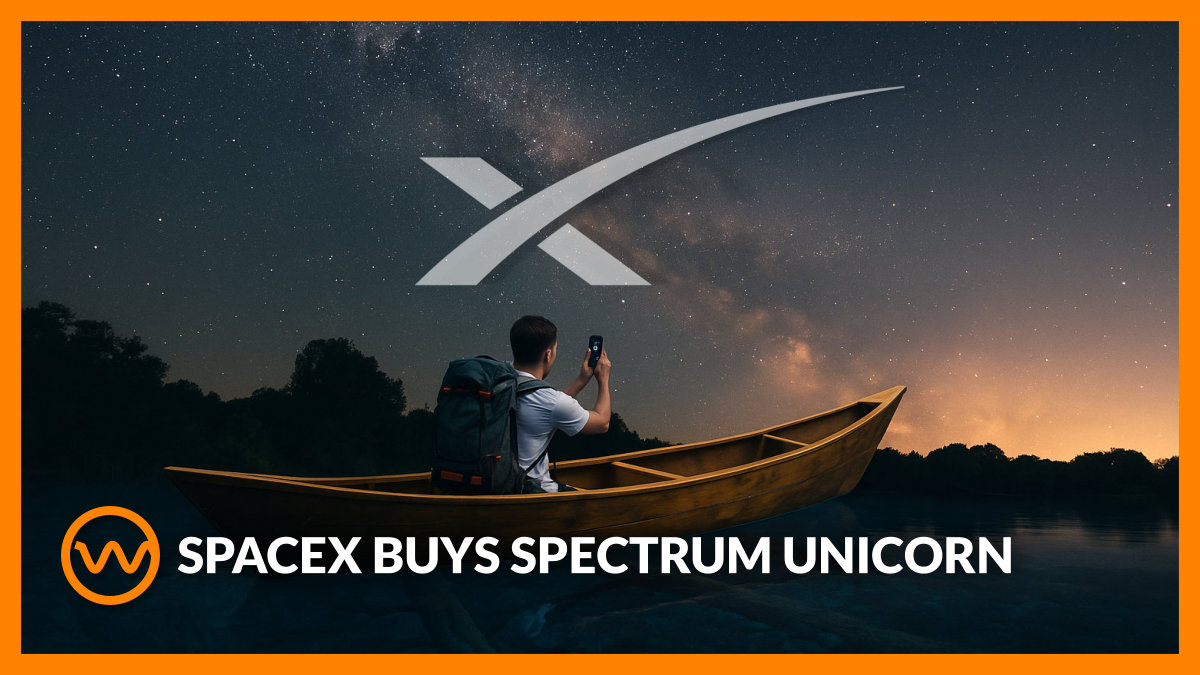ORBITAL WHISPERS

TL;DR
SpaceX bought EchoStar’s unused S-band and MSS spectrum for $17B to scale up Starlink’s Direct to Cell network.
The current service technically works but is still low-capacity. The real play is using exclusive spectrum + new satellites to build a pseudo-5G network from orbit, leveraging telco partners—for now.
The service shines in PR-driven emergency stories but underdelivers on real data speeds today.
This is less about consumer phones and more about owning the global connectivity infrastructure chessboard.

SpaceX Buys Spectrum Unicorn
SpaceX just bought a spectrum skeleton and hijacked the race to your phone
Cell coverage used to drop when you drove past the last Starbucks. Now it drops only if you’re under a roof or in a canyon, thanks to a company that thinks latency is a personality flaw. SpaceX announced that Starlink Direct to Cell is already the largest 4G coverage network on Earth. Not fastest, not cheapest, just biggest. That’s the claim. But the fine print is where things get interesting.
The big move is the seventeen billion dollar acquisition of spectrum licenses from EchoStar. Half of it came in cash, the rest in SpaceX stock and debt payments. This was a buyout of regulatory baggage. EchoStar was sitting on underused spectrum while the FCC warmed up its enforcement pen. Now that spectrum belongs to Elon, and EchoStar’s stock reacted like someone gave it CPR and an espresso. It spiked twenty percent, which surprised no one paying attention. The company went from losing licenses to gaining a lifeline.
That would be the entire story if it weren’t for AST SpaceMobile, the rival company that isn’t pretending satellite-to-phone is magic. AST has its own satellites, its own deals, and a plan that doesn’t rely on volume. While Starlink fires up thousands of mini sats, AST is betting on a handful of orbital monsters with antennas the size of parking lots. They’re aiming for voice, data, and video, actual 5G performance, not the emoji version. They already have partnerships with AT&T, Verizon, Vodafone, Rakuten, and FirstNet. So yes, while SpaceX was celebrating six million users sending text messages in the wilderness, AST was showing throughput between fourteen and twenty-one megabits per second in public trials.
But AST doesn’t have Musk. They don’t have the lasers. When the EchoStar deal dropped, AST’s stock dipped, because investors realized that being second in a race where the first guy owns the track, the airspace, and now the spectrum is not ideal. Still, AST’s stock has jumped this year on the strength of actual bandwidth and working demonstrations.
Meanwhile, SpaceX is still in early stages. The current version of Direct to Cell works best outside, in perfect conditions, with no obstructions. Speeds hover around four megabits per second, which is enough for texting, light app use, and sending location pins. Not Netflix, not FaceTime, but something. The pitch is that you don’t need to change your phone, your firmware, or your app. You just need to be standing in the open and hope the satellite feels like talking.
The rest of the story is coated in emergency goodwill. Messages during hurricanes. Alerts during wildfires. Texts from car crashes in zones where trees outnumber towers. The real move is control. With the new spectrum, SpaceX no longer has to depend on anyone. The telco partners are useful now. They won’t be forever.
AST is building big and slow. SpaceX is building wide and fast. One wants to deliver 5G in full, the other wants to deliver it in headlines. But the EchoStar deal changed the rules. SpaceX went from competing with AST to owning the road they’re both on.
None of this means the coverage is good yet. It means the positioning is excellent. For a company like EchoStar, the deal pulled them out of a regulatory spiral and launched them into relevance. For AST, it’s pressure. For SpaceX, it’s leverage. For users, it’s not a revolution. It’s a network in progress, delivered from space, at a speed that barely qualifies as broadband.
But it works. Sometimes.
Comments

Restricted Content
This content is sealed tighter than a procurement meeting on Friday at 4 p.m. To get in, you’ll need clearance, ideally accompanied by a badge, a budget code, and the ability to nod through three acronyms you don’t understand.
Push the button. You know you want to.
Or don’t. We’re not here to tell you how to live.


Join the discussion
Please log in to comment.